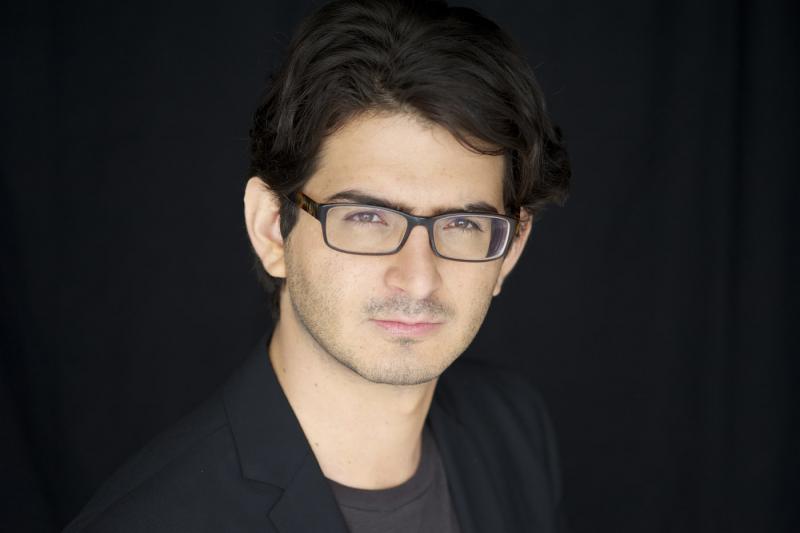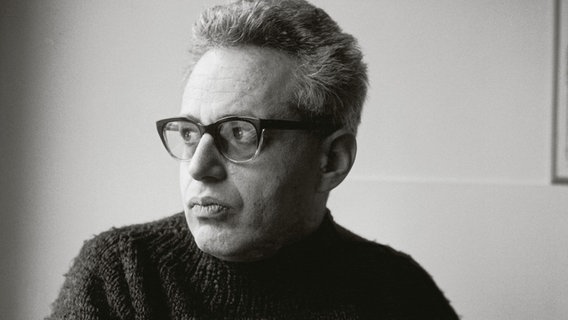Matan Porat, Wigmore Hall | reviews, news & interviews
Matan Porat, Wigmore Hall
Matan Porat, Wigmore Hall
Young Israeli pianist aims big, with intelligence to spare, in Ligeti, Rameau and Schubert

From now until 12 September, when Wigmore darling Iestyn Davies returns to open the new season, the biggest names in instrumental music are to be heard in the biggest venue, the Albert Hall. With all eyes and ears turned by maximum publicity towards the Proms, folk may have forgotten that the Wigmore Hall concerts were ongoing until last night.
What a bracing opener Ligeti’s Musica ricercata makes (the composer around the time of composition, pictured below). Composed in the middle of the 20th century, it’s a seminal piece of musical development from one pitch to 12, though there are only 11 pieces because the first unexpectedly ends, with typically Ligetian wit beautifully timed by Porat, on a second note. Until then we’ve had a fantasia on all the As of the keyboard; you could call it Minimalism before its time, but there’s more rhythmic energy and surprise than in a whole act of a Philip Glass opera. Porat’s well-weighted volume and intelligence brought out fleeting allusions, especially to Hungarian music and to the then-inescapable Bartók, whom Ligeti homages in a serious memorial. The most spellbinding of the pieces is the seventh, with a hypnotic seven-note pattern in the left hand and a cantabile melody, which Porat delivered with a completely different voice, in the right.
 Ligeti’s last piece, weaving a rich contrapuntal fantasy on a memorable, even singable twelve-note theme in homage to Frescobaldi, paved the way for Rameau’s Suite in A minor. Not much point in lamenting that the full-toned piano treatment was a million miles away from the harpsichord; Porat did occasionally scale down to ethereal sensitivity, but it never lasted for long. The concluding Gavotte et doubles, though, was an even, sweeping tour de force.
Ligeti’s last piece, weaving a rich contrapuntal fantasy on a memorable, even singable twelve-note theme in homage to Frescobaldi, paved the way for Rameau’s Suite in A minor. Not much point in lamenting that the full-toned piano treatment was a million miles away from the harpsichord; Porat did occasionally scale down to ethereal sensitivity, but it never lasted for long. The concluding Gavotte et doubles, though, was an even, sweeping tour de force.
Yet did all that forceful sonority, reminiscent of one of Porat’s teachers, Murray Perahia, in its clarity but heading towards George Benjamin, with whom he studied composition, in its near-fury, bode well for Schubert’s great D959 Sonata in A major? At the interval I was anxious, but in the event Porat provided a transfixing frame for the abysses which open up beneath the all too mortal Schubert’s tuneful feet. There was forthright focus – and, thank goodness, an exposition repeat to show true love and respect for the master – in the first movement, and an angry development, until the coda, which made a poignant dissolve with several waves of Prospero's wand. And Porat did show long-awaited pathos in the still meditations of the miraculously simple Andantino, only to open up the ground once more for central terrors which sounded absolutely modern.
Perhaps the concluding Rondo could have shown more inward serenity to fight the incipient triumph of death (Schubert died, aged 31, shortly after completing his three last sonatas) but again Porat steered it towards a luminous end. His encores were just as intriguing – a simple transcription, presumably the composer’s piano original, of the Adagietto from Mahler's Fifth Symphony, which went at the natural, unaffected pace you hear in Mahler acolyte Mengelberg’s recording; and pure virtuoso fun in the pianist’s own, Rachmaninov-style transcription of Piazzolla’s infinitely adaptable Libertango. Do try and hear this singular and confident voice among pianists when he returns in November.
rating
Share this article
The future of Arts Journalism
You can stop theartsdesk.com closing!
We urgently need financing to survive. Our fundraising drive has thus far raised £33,000 but we need to reach £100,000 or we will be forced to close. Please contribute here: https://gofund.me/c3f6033d
And if you can forward this information to anyone who might assist, we’d be grateful.

Subscribe to theartsdesk.com
Thank you for continuing to read our work on theartsdesk.com. For unlimited access to every article in its entirety, including our archive of more than 15,000 pieces, we're asking for £5 per month or £40 per year. We feel it's a very good deal, and hope you do too.
To take a subscription now simply click here.
And if you're looking for that extra gift for a friend or family member, why not treat them to a theartsdesk.com gift subscription?
more Classical music
 Connolly, BBC Philharmonic, Paterson, Bridgewater Hall, Manchester review - a journey through French splendours
Magic in lesser-known works of Duruflé and Chausson
Connolly, BBC Philharmonic, Paterson, Bridgewater Hall, Manchester review - a journey through French splendours
Magic in lesser-known works of Duruflé and Chausson
 Biss, National Symphony Orchestra, Kuokman, NCH Dublin review - full house goes wild for vivid epics
Passionate and precise playing of Brahms and Berlioz under a dancing master
Biss, National Symphony Orchestra, Kuokman, NCH Dublin review - full house goes wild for vivid epics
Passionate and precise playing of Brahms and Berlioz under a dancing master
 Verdi Requiem, Philharmonia, Muti, RFH review - new sparks from an old flame
Discoveries on a veteran maestro's epic journey
Verdi Requiem, Philharmonia, Muti, RFH review - new sparks from an old flame
Discoveries on a veteran maestro's epic journey
 Batsashvili, Hallé, Wong, Bridgewater Hall, Manchester review - a star in the piano universe
The Georgian pianist brings precision and freedom to Liszt’s warhorses
Batsashvili, Hallé, Wong, Bridgewater Hall, Manchester review - a star in the piano universe
The Georgian pianist brings precision and freedom to Liszt’s warhorses
 Naumov, SCO, Egarr, Queen's Hall, Edinburgh review - orchestral magic rescues some punishing music
Hard-driven Beethoven, monotonous Eötvös, some light from Kernis
Naumov, SCO, Egarr, Queen's Hall, Edinburgh review - orchestral magic rescues some punishing music
Hard-driven Beethoven, monotonous Eötvös, some light from Kernis
 Classical CDs: Shipping lines, sabre dances and sea lice
Neglected piano concertos, Italian art songs and new music for trombones
Classical CDs: Shipping lines, sabre dances and sea lice
Neglected piano concertos, Italian art songs and new music for trombones
 Il trionfo del Tempo e del Disinganno, Irish Baroque Orchestra, Whelan, St George’s Hanover Square review - Handel’s journey of a soul
Pleasure gets the best deal despite Beauty’s struggle to higher things
Il trionfo del Tempo e del Disinganno, Irish Baroque Orchestra, Whelan, St George’s Hanover Square review - Handel’s journey of a soul
Pleasure gets the best deal despite Beauty’s struggle to higher things
 Uproar, Rafferty, Royal Welsh College, Cardiff review - colourful new inventions inspired by Ligeti
Unfussy professionalism from Wales-based new music ensemble
Uproar, Rafferty, Royal Welsh College, Cardiff review - colourful new inventions inspired by Ligeti
Unfussy professionalism from Wales-based new music ensemble
 Attacca Quartet, Kings Place review - bridging the centuries in sound
Grammy-winning quartet bring more American punch than Gallic je-ne-sais-quoi to Ravel
Attacca Quartet, Kings Place review - bridging the centuries in sound
Grammy-winning quartet bring more American punch than Gallic je-ne-sais-quoi to Ravel
 Manchester Collective, RNCM review - exploring new territory
The string quartet – plus percussion and electronics – goes on a journey
Manchester Collective, RNCM review - exploring new territory
The string quartet – plus percussion and electronics – goes on a journey
 Bavouzet, BBCSO, Stasevska, Barbican review - ardent souls in mythic magic
Vivid realisation of fantastical masterpieces by Bartók, Ravel and Janáček
Bavouzet, BBCSO, Stasevska, Barbican review - ardent souls in mythic magic
Vivid realisation of fantastical masterpieces by Bartók, Ravel and Janáček

Add comment